Evaluating HRM at Woolworths: Strategies, Fit, and Analysis
VerifiedAdded on 2023/04/23
|9
|2452
|470
Report
AI Summary
This report provides an in-depth analysis of the Human Resource Management (HRM) system utilized by Woolworths, a major Australian company. It begins with an overview of Woolworths' strategic objectives and then delves into a situational analysis of its HRM strategies, employing a SWOT framework to identify strengths, weaknesses, opportunities, and threats. The report evaluates these strategies in the context of various HRM theories, including the configurational theory, behavioral science model, and matching model, focusing on talent management, leadership, and performance culture. Furthermore, it discusses the fit between Woolworths' HRM strategy and its overall business strategy, emphasizing the importance of aligning people-related decisions with organizational outcomes. The report concludes with recommendations for improving Woolworths' HRM system, such as focusing on new technology updates and finding alternative hardware update methods. This comprehensive analysis offers valuable insights into how Woolworths manages its human resources to achieve its strategic goals.
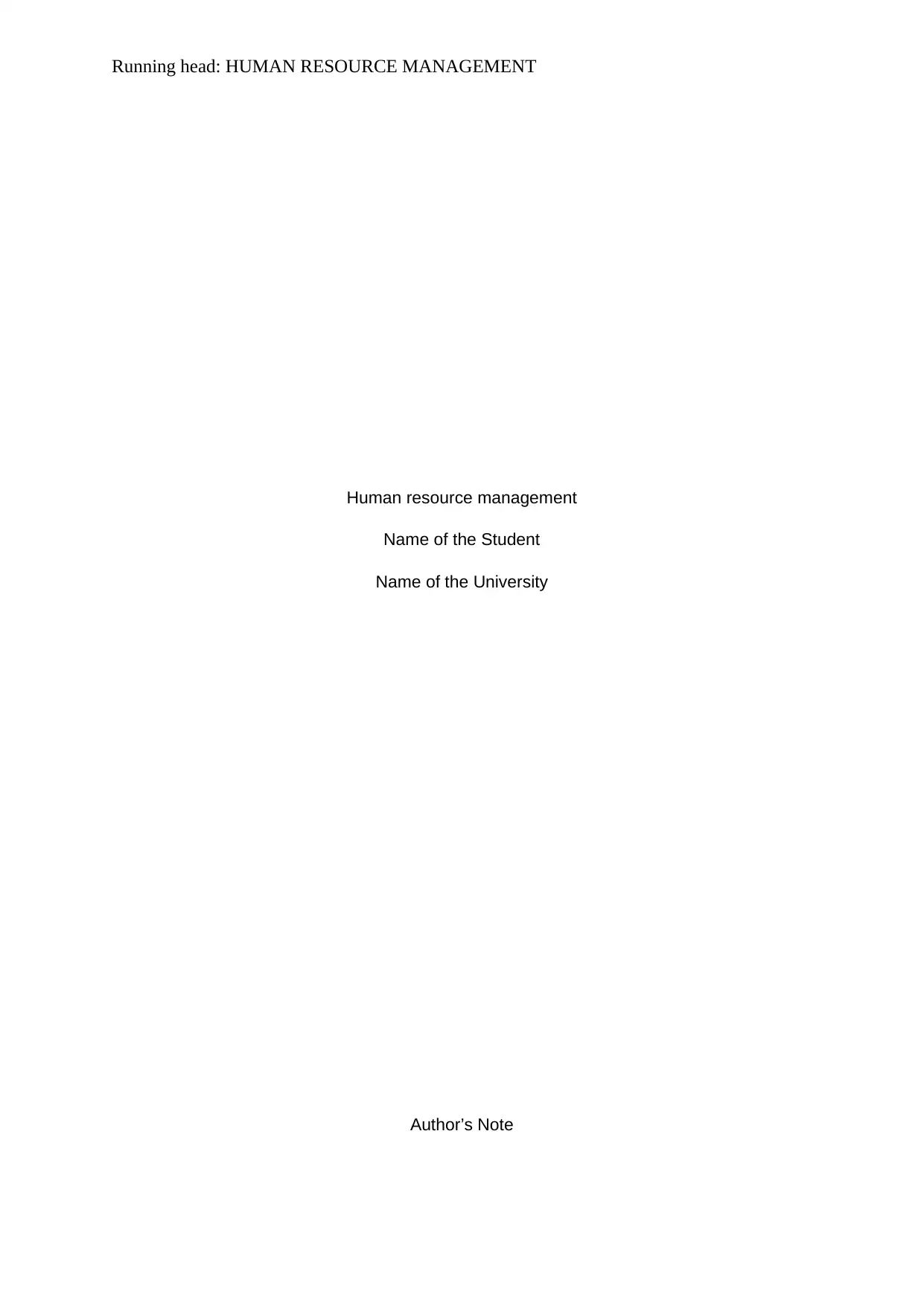
Running head: HUMAN RESOURCE MANAGEMENT
Human resource management
Name of the Student
Name of the University
Author’s Note
Human resource management
Name of the Student
Name of the University
Author’s Note
Paraphrase This Document
Need a fresh take? Get an instant paraphrase of this document with our AI Paraphraser
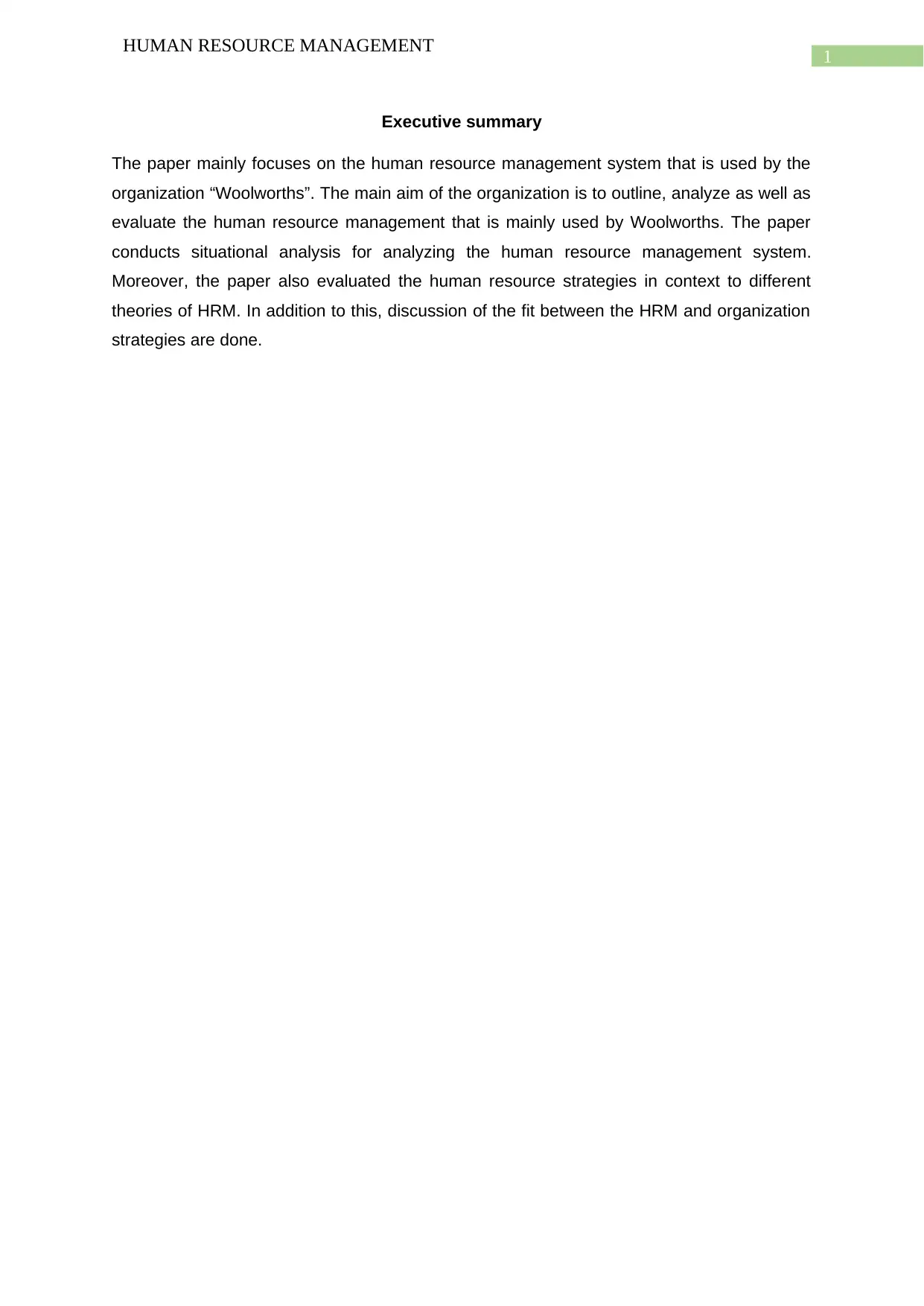
1
HUMAN RESOURCE MANAGEMENT
Executive summary
The paper mainly focuses on the human resource management system that is used by the
organization “Woolworths”. The main aim of the organization is to outline, analyze as well as
evaluate the human resource management that is mainly used by Woolworths. The paper
conducts situational analysis for analyzing the human resource management system.
Moreover, the paper also evaluated the human resource strategies in context to different
theories of HRM. In addition to this, discussion of the fit between the HRM and organization
strategies are done.
HUMAN RESOURCE MANAGEMENT
Executive summary
The paper mainly focuses on the human resource management system that is used by the
organization “Woolworths”. The main aim of the organization is to outline, analyze as well as
evaluate the human resource management that is mainly used by Woolworths. The paper
conducts situational analysis for analyzing the human resource management system.
Moreover, the paper also evaluated the human resource strategies in context to different
theories of HRM. In addition to this, discussion of the fit between the HRM and organization
strategies are done.
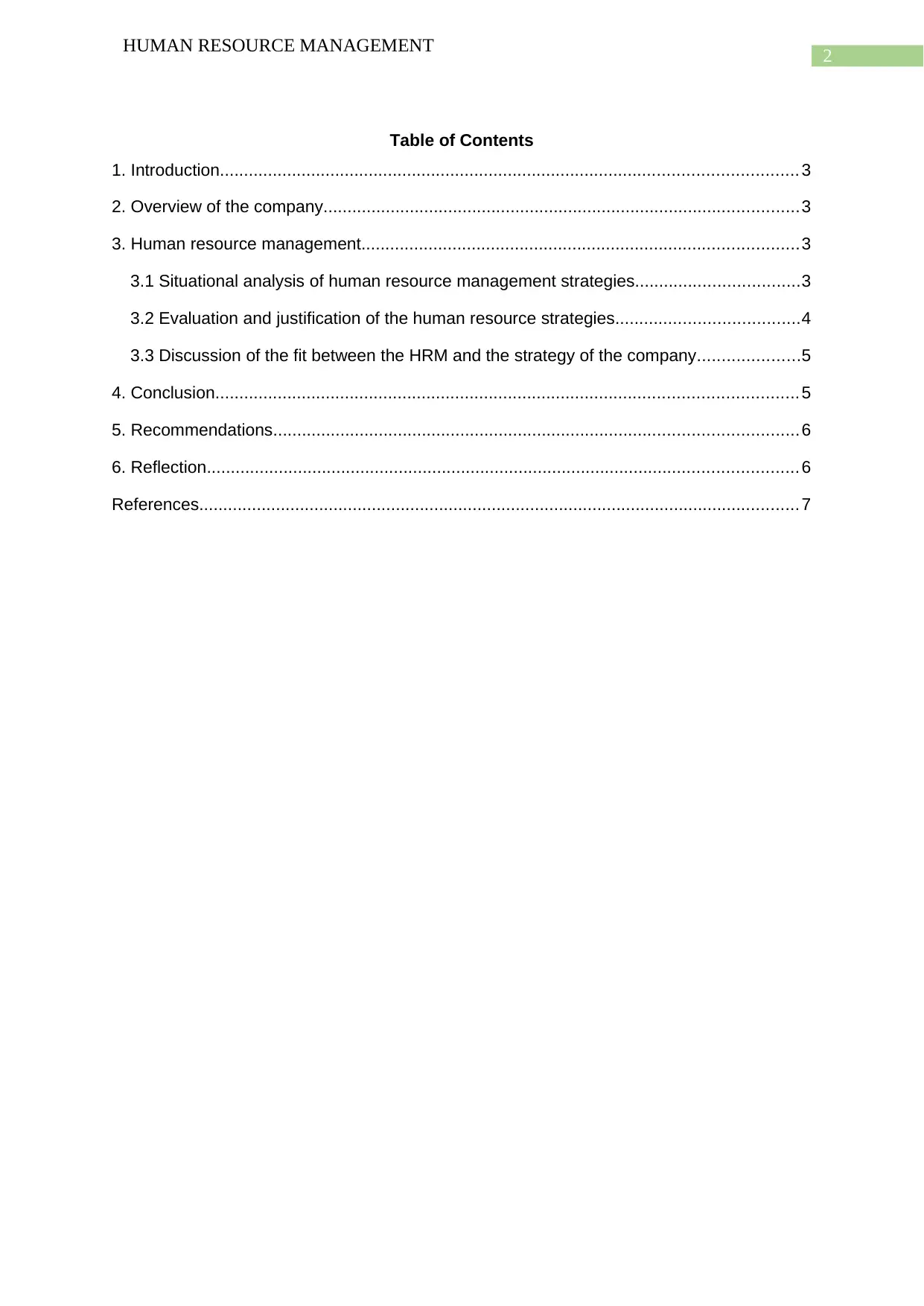
2
HUMAN RESOURCE MANAGEMENT
Table of Contents
1. Introduction........................................................................................................................ 3
2. Overview of the company...................................................................................................3
3. Human resource management...........................................................................................3
3.1 Situational analysis of human resource management strategies..................................3
3.2 Evaluation and justification of the human resource strategies......................................4
3.3 Discussion of the fit between the HRM and the strategy of the company.....................5
4. Conclusion......................................................................................................................... 5
5. Recommendations.............................................................................................................6
6. Reflection........................................................................................................................... 6
References............................................................................................................................. 7
HUMAN RESOURCE MANAGEMENT
Table of Contents
1. Introduction........................................................................................................................ 3
2. Overview of the company...................................................................................................3
3. Human resource management...........................................................................................3
3.1 Situational analysis of human resource management strategies..................................3
3.2 Evaluation and justification of the human resource strategies......................................4
3.3 Discussion of the fit between the HRM and the strategy of the company.....................5
4. Conclusion......................................................................................................................... 5
5. Recommendations.............................................................................................................6
6. Reflection........................................................................................................................... 6
References............................................................................................................................. 7
⊘ This is a preview!⊘
Do you want full access?
Subscribe today to unlock all pages.

Trusted by 1+ million students worldwide
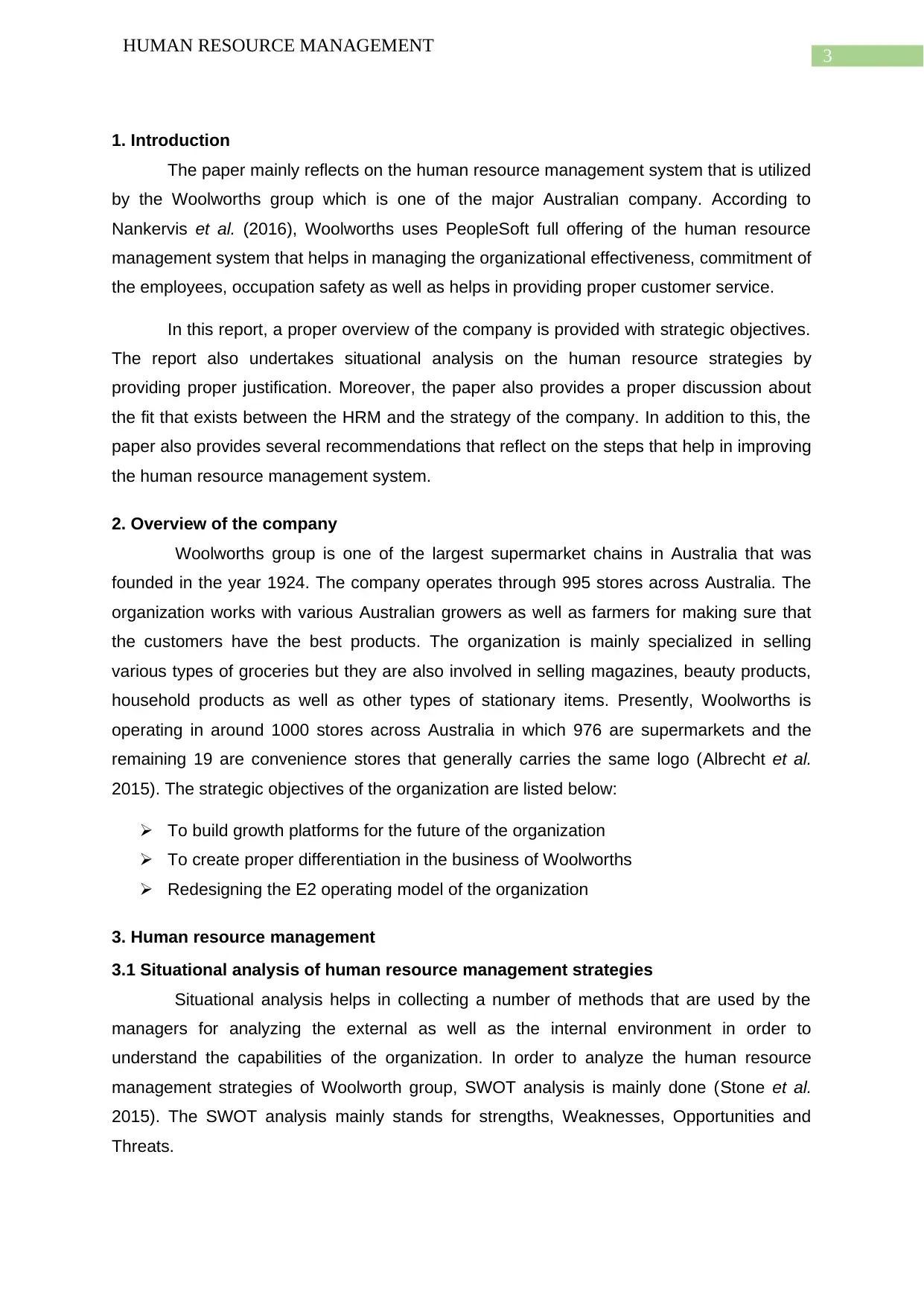
3
HUMAN RESOURCE MANAGEMENT
1. Introduction
The paper mainly reflects on the human resource management system that is utilized
by the Woolworths group which is one of the major Australian company. According to
Nankervis et al. (2016), Woolworths uses PeopleSoft full offering of the human resource
management system that helps in managing the organizational effectiveness, commitment of
the employees, occupation safety as well as helps in providing proper customer service.
In this report, a proper overview of the company is provided with strategic objectives.
The report also undertakes situational analysis on the human resource strategies by
providing proper justification. Moreover, the paper also provides a proper discussion about
the fit that exists between the HRM and the strategy of the company. In addition to this, the
paper also provides several recommendations that reflect on the steps that help in improving
the human resource management system.
2. Overview of the company
Woolworths group is one of the largest supermarket chains in Australia that was
founded in the year 1924. The company operates through 995 stores across Australia. The
organization works with various Australian growers as well as farmers for making sure that
the customers have the best products. The organization is mainly specialized in selling
various types of groceries but they are also involved in selling magazines, beauty products,
household products as well as other types of stationary items. Presently, Woolworths is
operating in around 1000 stores across Australia in which 976 are supermarkets and the
remaining 19 are convenience stores that generally carries the same logo (Albrecht et al.
2015). The strategic objectives of the organization are listed below:
To build growth platforms for the future of the organization
To create proper differentiation in the business of Woolworths
Redesigning the E2 operating model of the organization
3. Human resource management
3.1 Situational analysis of human resource management strategies
Situational analysis helps in collecting a number of methods that are used by the
managers for analyzing the external as well as the internal environment in order to
understand the capabilities of the organization. In order to analyze the human resource
management strategies of Woolworth group, SWOT analysis is mainly done (Stone et al.
2015). The SWOT analysis mainly stands for strengths, Weaknesses, Opportunities and
Threats.
HUMAN RESOURCE MANAGEMENT
1. Introduction
The paper mainly reflects on the human resource management system that is utilized
by the Woolworths group which is one of the major Australian company. According to
Nankervis et al. (2016), Woolworths uses PeopleSoft full offering of the human resource
management system that helps in managing the organizational effectiveness, commitment of
the employees, occupation safety as well as helps in providing proper customer service.
In this report, a proper overview of the company is provided with strategic objectives.
The report also undertakes situational analysis on the human resource strategies by
providing proper justification. Moreover, the paper also provides a proper discussion about
the fit that exists between the HRM and the strategy of the company. In addition to this, the
paper also provides several recommendations that reflect on the steps that help in improving
the human resource management system.
2. Overview of the company
Woolworths group is one of the largest supermarket chains in Australia that was
founded in the year 1924. The company operates through 995 stores across Australia. The
organization works with various Australian growers as well as farmers for making sure that
the customers have the best products. The organization is mainly specialized in selling
various types of groceries but they are also involved in selling magazines, beauty products,
household products as well as other types of stationary items. Presently, Woolworths is
operating in around 1000 stores across Australia in which 976 are supermarkets and the
remaining 19 are convenience stores that generally carries the same logo (Albrecht et al.
2015). The strategic objectives of the organization are listed below:
To build growth platforms for the future of the organization
To create proper differentiation in the business of Woolworths
Redesigning the E2 operating model of the organization
3. Human resource management
3.1 Situational analysis of human resource management strategies
Situational analysis helps in collecting a number of methods that are used by the
managers for analyzing the external as well as the internal environment in order to
understand the capabilities of the organization. In order to analyze the human resource
management strategies of Woolworth group, SWOT analysis is mainly done (Stone et al.
2015). The SWOT analysis mainly stands for strengths, Weaknesses, Opportunities and
Threats.
Paraphrase This Document
Need a fresh take? Get an instant paraphrase of this document with our AI Paraphraser
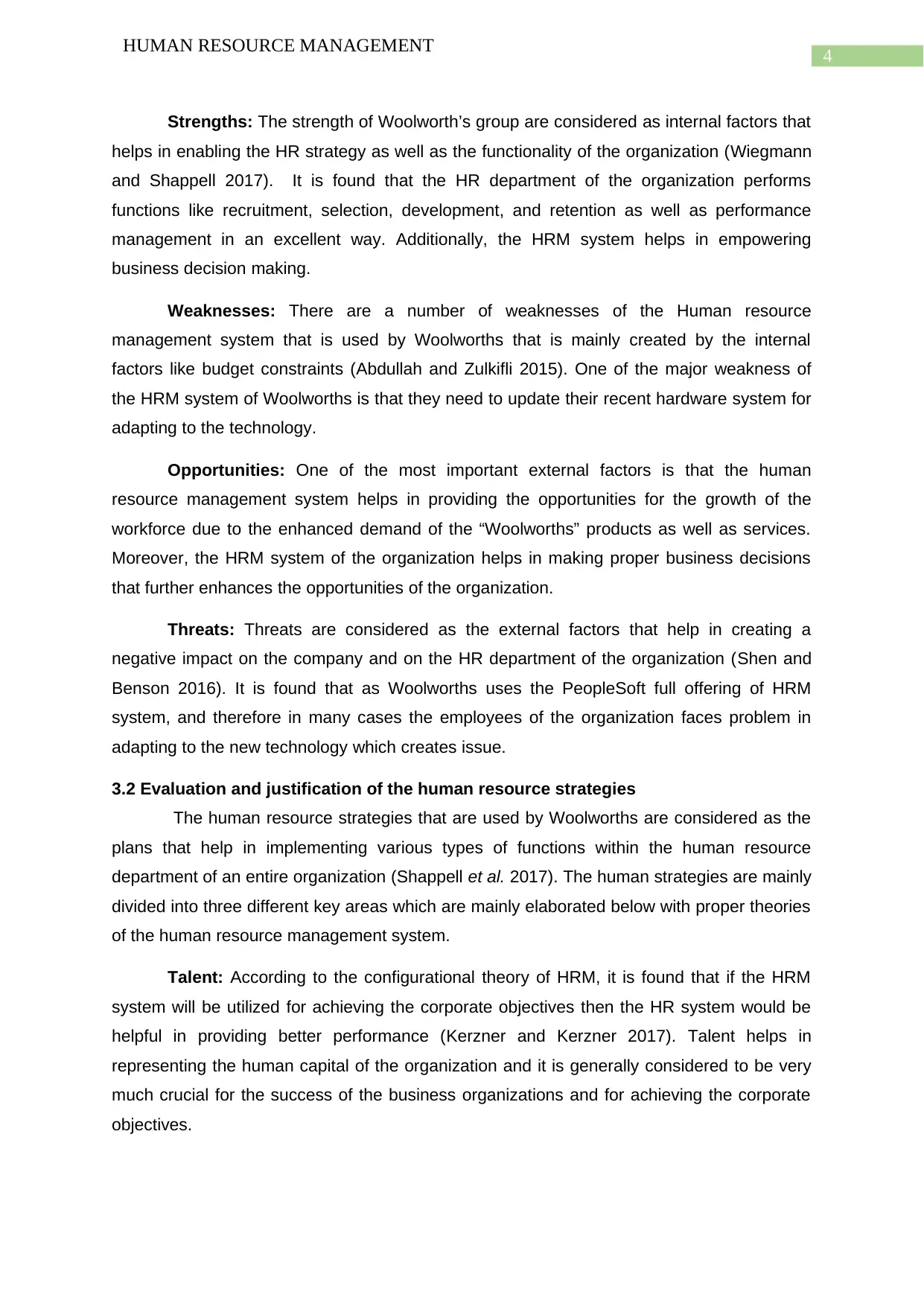
4
HUMAN RESOURCE MANAGEMENT
Strengths: The strength of Woolworth’s group are considered as internal factors that
helps in enabling the HR strategy as well as the functionality of the organization (Wiegmann
and Shappell 2017). It is found that the HR department of the organization performs
functions like recruitment, selection, development, and retention as well as performance
management in an excellent way. Additionally, the HRM system helps in empowering
business decision making.
Weaknesses: There are a number of weaknesses of the Human resource
management system that is used by Woolworths that is mainly created by the internal
factors like budget constraints (Abdullah and Zulkifli 2015). One of the major weakness of
the HRM system of Woolworths is that they need to update their recent hardware system for
adapting to the technology.
Opportunities: One of the most important external factors is that the human
resource management system helps in providing the opportunities for the growth of the
workforce due to the enhanced demand of the “Woolworths” products as well as services.
Moreover, the HRM system of the organization helps in making proper business decisions
that further enhances the opportunities of the organization.
Threats: Threats are considered as the external factors that help in creating a
negative impact on the company and on the HR department of the organization (Shen and
Benson 2016). It is found that as Woolworths uses the PeopleSoft full offering of HRM
system, and therefore in many cases the employees of the organization faces problem in
adapting to the new technology which creates issue.
3.2 Evaluation and justification of the human resource strategies
The human resource strategies that are used by Woolworths are considered as the
plans that help in implementing various types of functions within the human resource
department of an entire organization (Shappell et al. 2017). The human strategies are mainly
divided into three different key areas which are mainly elaborated below with proper theories
of the human resource management system.
Talent: According to the configurational theory of HRM, it is found that if the HRM
system will be utilized for achieving the corporate objectives then the HR system would be
helpful in providing better performance (Kerzner and Kerzner 2017). Talent helps in
representing the human capital of the organization and it is generally considered to be very
much crucial for the success of the business organizations and for achieving the corporate
objectives.
HUMAN RESOURCE MANAGEMENT
Strengths: The strength of Woolworth’s group are considered as internal factors that
helps in enabling the HR strategy as well as the functionality of the organization (Wiegmann
and Shappell 2017). It is found that the HR department of the organization performs
functions like recruitment, selection, development, and retention as well as performance
management in an excellent way. Additionally, the HRM system helps in empowering
business decision making.
Weaknesses: There are a number of weaknesses of the Human resource
management system that is used by Woolworths that is mainly created by the internal
factors like budget constraints (Abdullah and Zulkifli 2015). One of the major weakness of
the HRM system of Woolworths is that they need to update their recent hardware system for
adapting to the technology.
Opportunities: One of the most important external factors is that the human
resource management system helps in providing the opportunities for the growth of the
workforce due to the enhanced demand of the “Woolworths” products as well as services.
Moreover, the HRM system of the organization helps in making proper business decisions
that further enhances the opportunities of the organization.
Threats: Threats are considered as the external factors that help in creating a
negative impact on the company and on the HR department of the organization (Shen and
Benson 2016). It is found that as Woolworths uses the PeopleSoft full offering of HRM
system, and therefore in many cases the employees of the organization faces problem in
adapting to the new technology which creates issue.
3.2 Evaluation and justification of the human resource strategies
The human resource strategies that are used by Woolworths are considered as the
plans that help in implementing various types of functions within the human resource
department of an entire organization (Shappell et al. 2017). The human strategies are mainly
divided into three different key areas which are mainly elaborated below with proper theories
of the human resource management system.
Talent: According to the configurational theory of HRM, it is found that if the HRM
system will be utilized for achieving the corporate objectives then the HR system would be
helpful in providing better performance (Kerzner and Kerzner 2017). Talent helps in
representing the human capital of the organization and it is generally considered to be very
much crucial for the success of the business organizations and for achieving the corporate
objectives.
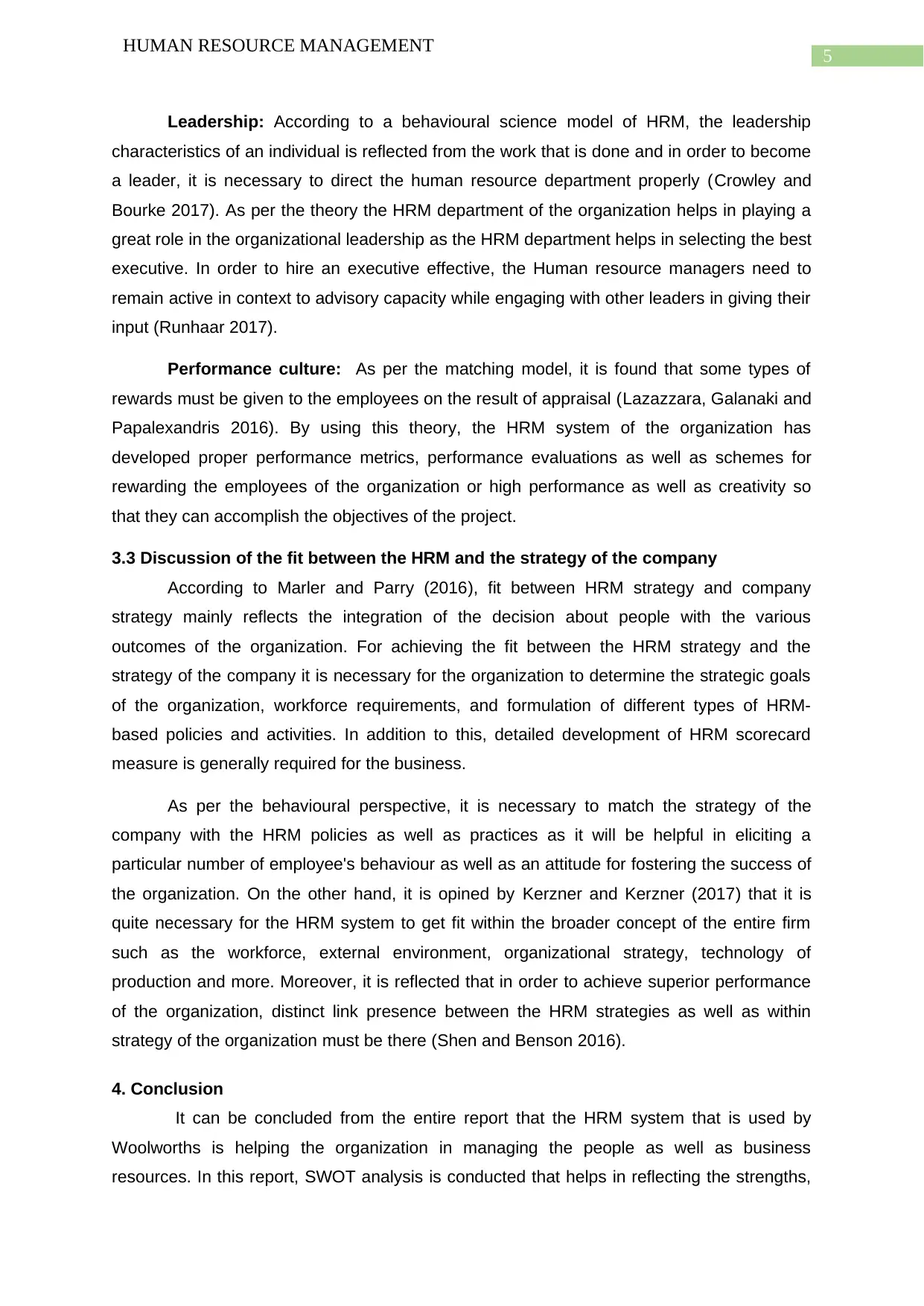
5
HUMAN RESOURCE MANAGEMENT
Leadership: According to a behavioural science model of HRM, the leadership
characteristics of an individual is reflected from the work that is done and in order to become
a leader, it is necessary to direct the human resource department properly (Crowley and
Bourke 2017). As per the theory the HRM department of the organization helps in playing a
great role in the organizational leadership as the HRM department helps in selecting the best
executive. In order to hire an executive effective, the Human resource managers need to
remain active in context to advisory capacity while engaging with other leaders in giving their
input (Runhaar 2017).
Performance culture: As per the matching model, it is found that some types of
rewards must be given to the employees on the result of appraisal (Lazazzara, Galanaki and
Papalexandris 2016). By using this theory, the HRM system of the organization has
developed proper performance metrics, performance evaluations as well as schemes for
rewarding the employees of the organization or high performance as well as creativity so
that they can accomplish the objectives of the project.
3.3 Discussion of the fit between the HRM and the strategy of the company
According to Marler and Parry (2016), fit between HRM strategy and company
strategy mainly reflects the integration of the decision about people with the various
outcomes of the organization. For achieving the fit between the HRM strategy and the
strategy of the company it is necessary for the organization to determine the strategic goals
of the organization, workforce requirements, and formulation of different types of HRM-
based policies and activities. In addition to this, detailed development of HRM scorecard
measure is generally required for the business.
As per the behavioural perspective, it is necessary to match the strategy of the
company with the HRM policies as well as practices as it will be helpful in eliciting a
particular number of employee's behaviour as well as an attitude for fostering the success of
the organization. On the other hand, it is opined by Kerzner and Kerzner (2017) that it is
quite necessary for the HRM system to get fit within the broader concept of the entire firm
such as the workforce, external environment, organizational strategy, technology of
production and more. Moreover, it is reflected that in order to achieve superior performance
of the organization, distinct link presence between the HRM strategies as well as within
strategy of the organization must be there (Shen and Benson 2016).
4. Conclusion
It can be concluded from the entire report that the HRM system that is used by
Woolworths is helping the organization in managing the people as well as business
resources. In this report, SWOT analysis is conducted that helps in reflecting the strengths,
HUMAN RESOURCE MANAGEMENT
Leadership: According to a behavioural science model of HRM, the leadership
characteristics of an individual is reflected from the work that is done and in order to become
a leader, it is necessary to direct the human resource department properly (Crowley and
Bourke 2017). As per the theory the HRM department of the organization helps in playing a
great role in the organizational leadership as the HRM department helps in selecting the best
executive. In order to hire an executive effective, the Human resource managers need to
remain active in context to advisory capacity while engaging with other leaders in giving their
input (Runhaar 2017).
Performance culture: As per the matching model, it is found that some types of
rewards must be given to the employees on the result of appraisal (Lazazzara, Galanaki and
Papalexandris 2016). By using this theory, the HRM system of the organization has
developed proper performance metrics, performance evaluations as well as schemes for
rewarding the employees of the organization or high performance as well as creativity so
that they can accomplish the objectives of the project.
3.3 Discussion of the fit between the HRM and the strategy of the company
According to Marler and Parry (2016), fit between HRM strategy and company
strategy mainly reflects the integration of the decision about people with the various
outcomes of the organization. For achieving the fit between the HRM strategy and the
strategy of the company it is necessary for the organization to determine the strategic goals
of the organization, workforce requirements, and formulation of different types of HRM-
based policies and activities. In addition to this, detailed development of HRM scorecard
measure is generally required for the business.
As per the behavioural perspective, it is necessary to match the strategy of the
company with the HRM policies as well as practices as it will be helpful in eliciting a
particular number of employee's behaviour as well as an attitude for fostering the success of
the organization. On the other hand, it is opined by Kerzner and Kerzner (2017) that it is
quite necessary for the HRM system to get fit within the broader concept of the entire firm
such as the workforce, external environment, organizational strategy, technology of
production and more. Moreover, it is reflected that in order to achieve superior performance
of the organization, distinct link presence between the HRM strategies as well as within
strategy of the organization must be there (Shen and Benson 2016).
4. Conclusion
It can be concluded from the entire report that the HRM system that is used by
Woolworths is helping the organization in managing the people as well as business
resources. In this report, SWOT analysis is conducted that helps in reflecting the strengths,
⊘ This is a preview!⊘
Do you want full access?
Subscribe today to unlock all pages.

Trusted by 1+ million students worldwide
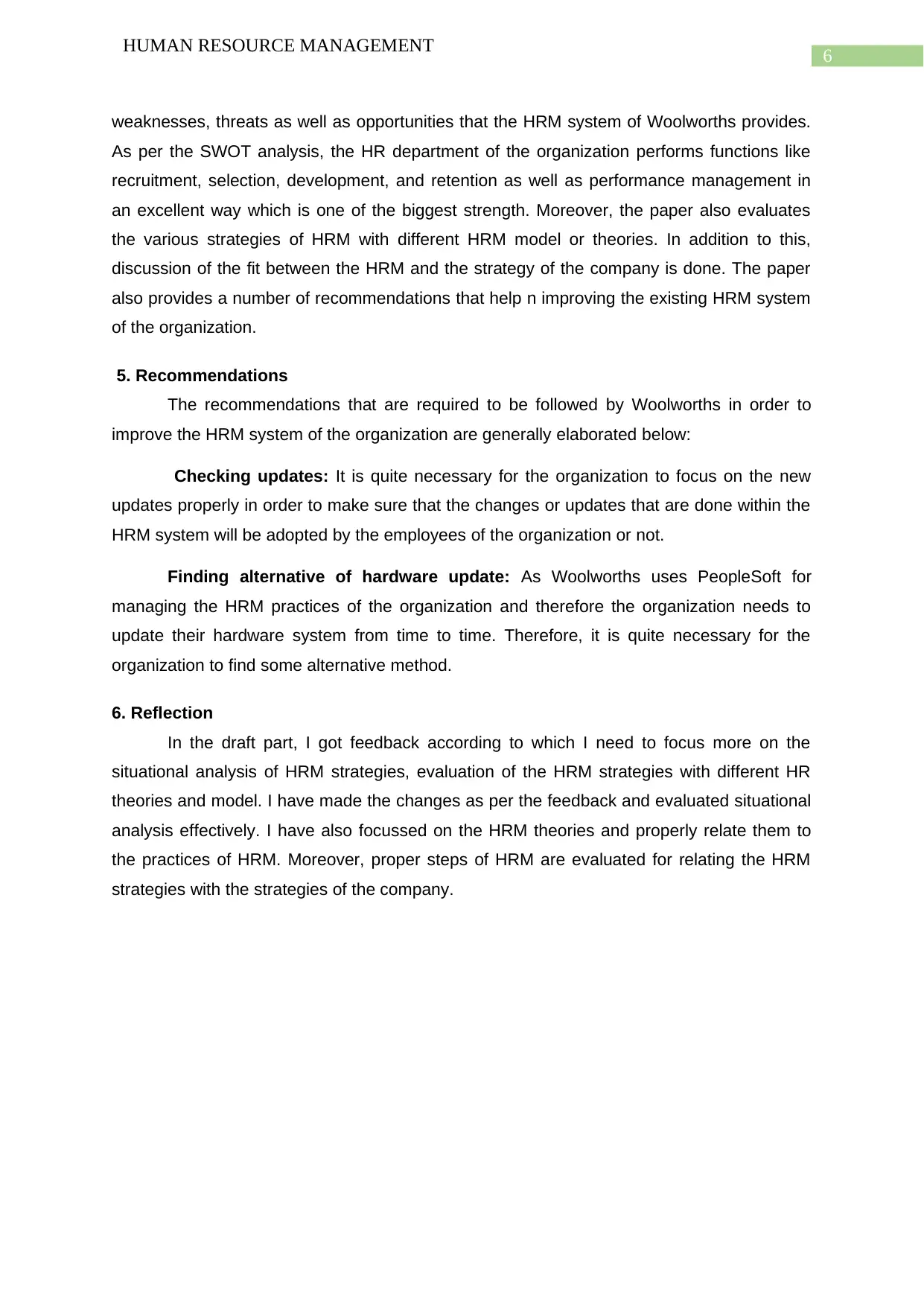
6
HUMAN RESOURCE MANAGEMENT
weaknesses, threats as well as opportunities that the HRM system of Woolworths provides.
As per the SWOT analysis, the HR department of the organization performs functions like
recruitment, selection, development, and retention as well as performance management in
an excellent way which is one of the biggest strength. Moreover, the paper also evaluates
the various strategies of HRM with different HRM model or theories. In addition to this,
discussion of the fit between the HRM and the strategy of the company is done. The paper
also provides a number of recommendations that help n improving the existing HRM system
of the organization.
5. Recommendations
The recommendations that are required to be followed by Woolworths in order to
improve the HRM system of the organization are generally elaborated below:
Checking updates: It is quite necessary for the organization to focus on the new
updates properly in order to make sure that the changes or updates that are done within the
HRM system will be adopted by the employees of the organization or not.
Finding alternative of hardware update: As Woolworths uses PeopleSoft for
managing the HRM practices of the organization and therefore the organization needs to
update their hardware system from time to time. Therefore, it is quite necessary for the
organization to find some alternative method.
6. Reflection
In the draft part, I got feedback according to which I need to focus more on the
situational analysis of HRM strategies, evaluation of the HRM strategies with different HR
theories and model. I have made the changes as per the feedback and evaluated situational
analysis effectively. I have also focussed on the HRM theories and properly relate them to
the practices of HRM. Moreover, proper steps of HRM are evaluated for relating the HRM
strategies with the strategies of the company.
HUMAN RESOURCE MANAGEMENT
weaknesses, threats as well as opportunities that the HRM system of Woolworths provides.
As per the SWOT analysis, the HR department of the organization performs functions like
recruitment, selection, development, and retention as well as performance management in
an excellent way which is one of the biggest strength. Moreover, the paper also evaluates
the various strategies of HRM with different HRM model or theories. In addition to this,
discussion of the fit between the HRM and the strategy of the company is done. The paper
also provides a number of recommendations that help n improving the existing HRM system
of the organization.
5. Recommendations
The recommendations that are required to be followed by Woolworths in order to
improve the HRM system of the organization are generally elaborated below:
Checking updates: It is quite necessary for the organization to focus on the new
updates properly in order to make sure that the changes or updates that are done within the
HRM system will be adopted by the employees of the organization or not.
Finding alternative of hardware update: As Woolworths uses PeopleSoft for
managing the HRM practices of the organization and therefore the organization needs to
update their hardware system from time to time. Therefore, it is quite necessary for the
organization to find some alternative method.
6. Reflection
In the draft part, I got feedback according to which I need to focus more on the
situational analysis of HRM strategies, evaluation of the HRM strategies with different HR
theories and model. I have made the changes as per the feedback and evaluated situational
analysis effectively. I have also focussed on the HRM theories and properly relate them to
the practices of HRM. Moreover, proper steps of HRM are evaluated for relating the HRM
strategies with the strategies of the company.
Paraphrase This Document
Need a fresh take? Get an instant paraphrase of this document with our AI Paraphraser
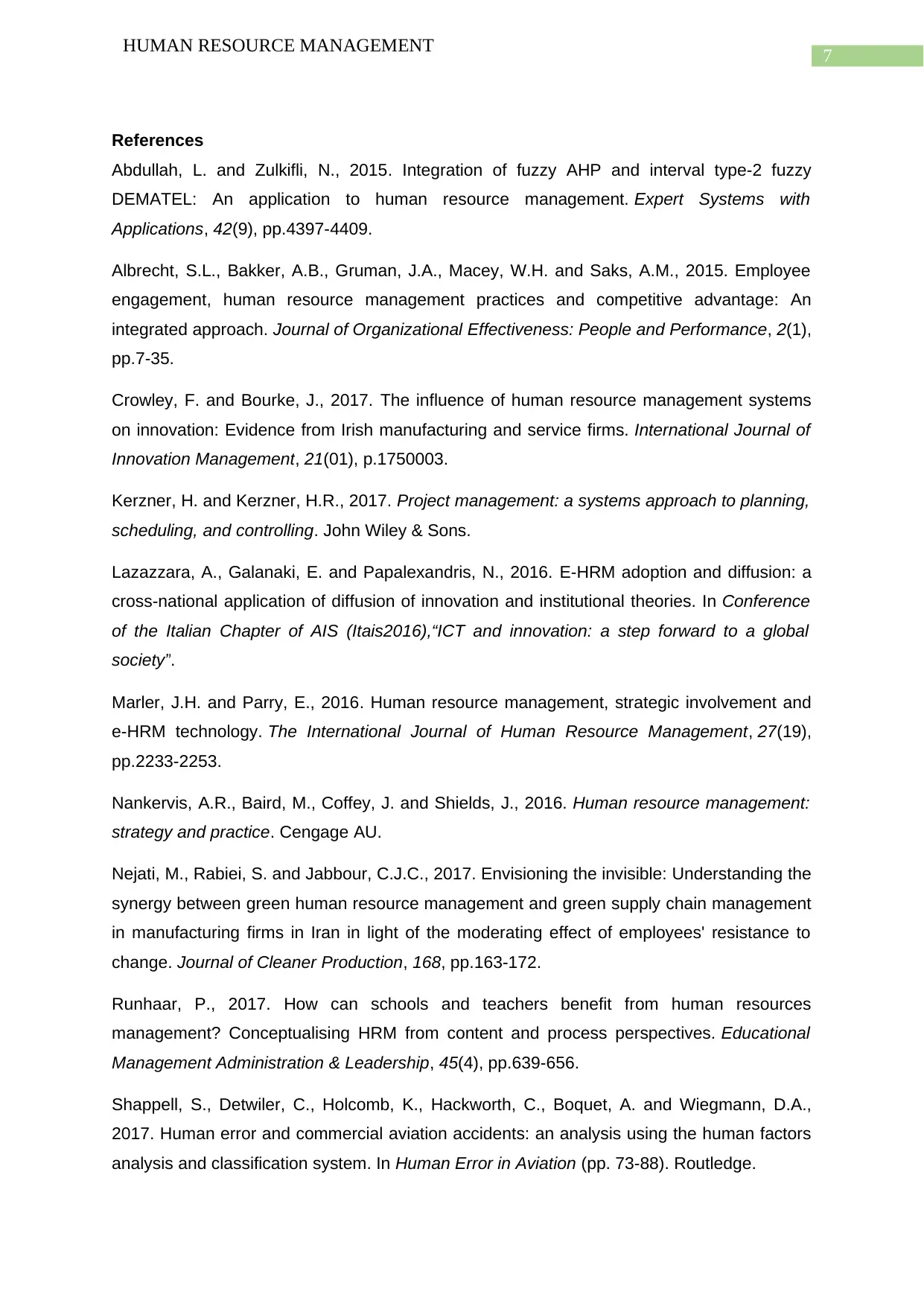
7
HUMAN RESOURCE MANAGEMENT
References
Abdullah, L. and Zulkifli, N., 2015. Integration of fuzzy AHP and interval type-2 fuzzy
DEMATEL: An application to human resource management. Expert Systems with
Applications, 42(9), pp.4397-4409.
Albrecht, S.L., Bakker, A.B., Gruman, J.A., Macey, W.H. and Saks, A.M., 2015. Employee
engagement, human resource management practices and competitive advantage: An
integrated approach. Journal of Organizational Effectiveness: People and Performance, 2(1),
pp.7-35.
Crowley, F. and Bourke, J., 2017. The influence of human resource management systems
on innovation: Evidence from Irish manufacturing and service firms. International Journal of
Innovation Management, 21(01), p.1750003.
Kerzner, H. and Kerzner, H.R., 2017. Project management: a systems approach to planning,
scheduling, and controlling. John Wiley & Sons.
Lazazzara, A., Galanaki, E. and Papalexandris, N., 2016. E-HRM adoption and diffusion: a
cross-national application of diffusion of innovation and institutional theories. In Conference
of the Italian Chapter of AIS (Itais2016),“ICT and innovation: a step forward to a global
society”.
Marler, J.H. and Parry, E., 2016. Human resource management, strategic involvement and
e-HRM technology. The International Journal of Human Resource Management, 27(19),
pp.2233-2253.
Nankervis, A.R., Baird, M., Coffey, J. and Shields, J., 2016. Human resource management:
strategy and practice. Cengage AU.
Nejati, M., Rabiei, S. and Jabbour, C.J.C., 2017. Envisioning the invisible: Understanding the
synergy between green human resource management and green supply chain management
in manufacturing firms in Iran in light of the moderating effect of employees' resistance to
change. Journal of Cleaner Production, 168, pp.163-172.
Runhaar, P., 2017. How can schools and teachers benefit from human resources
management? Conceptualising HRM from content and process perspectives. Educational
Management Administration & Leadership, 45(4), pp.639-656.
Shappell, S., Detwiler, C., Holcomb, K., Hackworth, C., Boquet, A. and Wiegmann, D.A.,
2017. Human error and commercial aviation accidents: an analysis using the human factors
analysis and classification system. In Human Error in Aviation (pp. 73-88). Routledge.
HUMAN RESOURCE MANAGEMENT
References
Abdullah, L. and Zulkifli, N., 2015. Integration of fuzzy AHP and interval type-2 fuzzy
DEMATEL: An application to human resource management. Expert Systems with
Applications, 42(9), pp.4397-4409.
Albrecht, S.L., Bakker, A.B., Gruman, J.A., Macey, W.H. and Saks, A.M., 2015. Employee
engagement, human resource management practices and competitive advantage: An
integrated approach. Journal of Organizational Effectiveness: People and Performance, 2(1),
pp.7-35.
Crowley, F. and Bourke, J., 2017. The influence of human resource management systems
on innovation: Evidence from Irish manufacturing and service firms. International Journal of
Innovation Management, 21(01), p.1750003.
Kerzner, H. and Kerzner, H.R., 2017. Project management: a systems approach to planning,
scheduling, and controlling. John Wiley & Sons.
Lazazzara, A., Galanaki, E. and Papalexandris, N., 2016. E-HRM adoption and diffusion: a
cross-national application of diffusion of innovation and institutional theories. In Conference
of the Italian Chapter of AIS (Itais2016),“ICT and innovation: a step forward to a global
society”.
Marler, J.H. and Parry, E., 2016. Human resource management, strategic involvement and
e-HRM technology. The International Journal of Human Resource Management, 27(19),
pp.2233-2253.
Nankervis, A.R., Baird, M., Coffey, J. and Shields, J., 2016. Human resource management:
strategy and practice. Cengage AU.
Nejati, M., Rabiei, S. and Jabbour, C.J.C., 2017. Envisioning the invisible: Understanding the
synergy between green human resource management and green supply chain management
in manufacturing firms in Iran in light of the moderating effect of employees' resistance to
change. Journal of Cleaner Production, 168, pp.163-172.
Runhaar, P., 2017. How can schools and teachers benefit from human resources
management? Conceptualising HRM from content and process perspectives. Educational
Management Administration & Leadership, 45(4), pp.639-656.
Shappell, S., Detwiler, C., Holcomb, K., Hackworth, C., Boquet, A. and Wiegmann, D.A.,
2017. Human error and commercial aviation accidents: an analysis using the human factors
analysis and classification system. In Human Error in Aviation (pp. 73-88). Routledge.
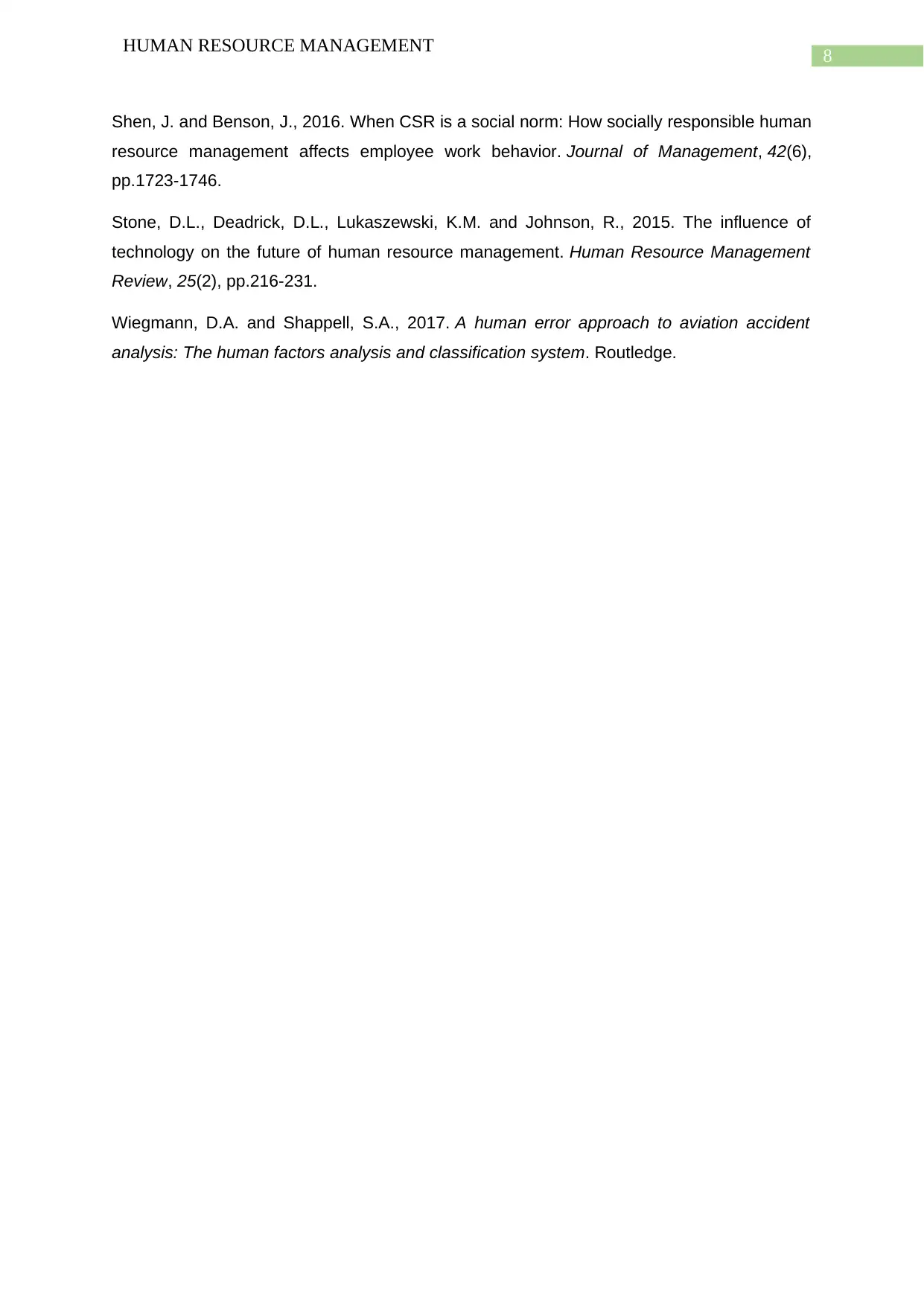
8
HUMAN RESOURCE MANAGEMENT
Shen, J. and Benson, J., 2016. When CSR is a social norm: How socially responsible human
resource management affects employee work behavior. Journal of Management, 42(6),
pp.1723-1746.
Stone, D.L., Deadrick, D.L., Lukaszewski, K.M. and Johnson, R., 2015. The influence of
technology on the future of human resource management. Human Resource Management
Review, 25(2), pp.216-231.
Wiegmann, D.A. and Shappell, S.A., 2017. A human error approach to aviation accident
analysis: The human factors analysis and classification system. Routledge.
HUMAN RESOURCE MANAGEMENT
Shen, J. and Benson, J., 2016. When CSR is a social norm: How socially responsible human
resource management affects employee work behavior. Journal of Management, 42(6),
pp.1723-1746.
Stone, D.L., Deadrick, D.L., Lukaszewski, K.M. and Johnson, R., 2015. The influence of
technology on the future of human resource management. Human Resource Management
Review, 25(2), pp.216-231.
Wiegmann, D.A. and Shappell, S.A., 2017. A human error approach to aviation accident
analysis: The human factors analysis and classification system. Routledge.
⊘ This is a preview!⊘
Do you want full access?
Subscribe today to unlock all pages.

Trusted by 1+ million students worldwide
1 out of 9
Related Documents
Your All-in-One AI-Powered Toolkit for Academic Success.
+13062052269
info@desklib.com
Available 24*7 on WhatsApp / Email
![[object Object]](/_next/static/media/star-bottom.7253800d.svg)
Unlock your academic potential
Copyright © 2020–2025 A2Z Services. All Rights Reserved. Developed and managed by ZUCOL.





